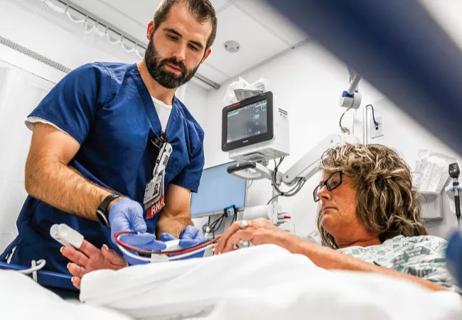Peer-to-peer videos offer creative solution to help patients while they wait

The youth mental health crisis has been identified as a public health emergency, and one of the many places providers are seeing the impact is in the emergency department. Without enough specialists to help all these patients, hospitals need to look for creative solutions to provide stopgap support, says Purva Grover, MD, a pediatric emergency physician and medical director for Cleveland Clinic’s pediatric emergency departments.
Advertisement
Cleveland Clinic is a non-profit academic medical center. Advertising on our site helps support our mission. We do not endorse non-Cleveland Clinic products or services. Policy
“We’ve really seen an uptick in the number of kids coming in for help and care, and with that comes a disproportion of resources,” she says. “There is more demand than supply, which means fewer and fewer outpatient specialists to match the needs of these patients.”
Dr. Grover is developing a pilot project that would create educational videos on mental health coping skills that could be shared with youth in crisis. The idea was sparked by seeing the long wait times youth mental health patients typically spend in the ED and a desire to give staff some kind of tool that could help.
“This is not in any way, shape, or form a substitute or even a supplement, frankly, to what they really need,” she says. “It’s just a small token of trying to do something in that long period of time while they wait.”
In the last five years, pediatric mental health visits to emergency departments for issues like depression, anxiety and behavioral challenges have increased by more than 45%. At Cleveland Clinic’s pediatric emergency room, patients younger than 21 seeking mental health care increased by almost 300%.
But these young patients in crisis face significantly longer wait times than those seeking care for a physical concern. The average length of stay for general complaints is 90 minutes for patients being released, or up to three hours for patients being admitted. In contrast, pediatric mental health patients spend an average of three to four hours in the ED before being discharged, allowing time to ensure their mental state is stable and conditions at home are safe. Because of this, national data show that these patients have a prolonged length of stay, which have shown a progressive increase over a 10-year period, including visits lasting more than 12 hours.
Advertisement
While longer-term solutions are needed, Dr. Grover says emergency departments can also look for ways to better support these patients with the resources they already have.
For her pilot project, made possible with a Cleveland Clinic Catalyst Grant, Dr. Grover is partnering with a Cleveland Clinic psychiatrist and the healthcare system’s video production team to create short videos targeted to different age groups.
These will include peer-to-peer videos in which young people will share unscripted testimonials about their own mental health struggles, and how they got through it. “I want it to be real,” Dr. Grover says. “With these patients, I can try to connect with them, I can empathize, but I don’t know what it’s like to walk in their shoes.”
The videos will also include short educational programs with generalized therapies or skills provided by a Cleveland Clinic psychiatrist or psychologist. These will include techniques from cognitive behavior and dialectical behavior therapies for managing stress and providing comfort.
The videos will be loaded onto iPads that can be provided to patients, giving them evidence-based support while they wait.
While the videos are not expected to be available outside of Cleveland Clinic, Dr. Grover says it’s an example of how emergency departments can think outside the box and look for ways to support these patients at a scale that makes sense for their organization. Smaller hospital systems, for example, could produce simple mental health videos with as little as a smart phone, she says.
Advertisement
A simple change providers can make to improve care is to make sure pediatric mental health patients are reevaluated at every shift, she adds. A patient in crisis may have calmed down or be in a different frame of mind, creating different intervention options.
Most importantly, she urges providers not to give up and to enlist wider support to find meaningful solutions, which can range from low-hanging fruit to bigger infrastructural changes that require a heavier lift.
“This is not something you’re trying to do alone,” she said. “This is really an organizational effort, and you need to have the backing of your organization for this.”
Advertisement
Advertisement

This technical solution expedites the patient’s ED to admissions process

Akron General and Union Hospital increase throughput and patient satisfaction by rethinking their approach to care

Remotely based physicians use telehealth technology to evaluate lower-acuity patients in the ED, express clinic or during an EMS response

A closer look at current uses and future opportunities

Promoting accessibility for all children

Patient navigator is the bridge across systems

5 things a child psychiatrist wishes all pediatricians would do

Caregiver collaboration and patient education remain critical